DHAKA, Bangladesh
A dead whale was found on a beach in southern Cox’s Bazar in Bangladesh, according to officials on Saturday.
The carcass washed ashore on Shamlapur beach in the Teknaf area late Friday. It was buried near the beach because of its rotting condition and bad aroma, Teknaf chief government executive officer Parvez Chowdhury told Anadolu Agency.
Dr. Md. Shawkat Ali, a Teknaf government livestock officer under the Ministry of Fisheries and Livestock, confirmed the size of the whale to be nearly 10.06 meters (33 feet) long and 3.20 meters (10 feet) wide because there was different information from officials.
“We have examined the sample collected from the body of the dead whale and found that it died from stomach perforation. The whale might have died days to a week ago at sea and gradually drifted to shore,” he told Anadolu Agency.
Ali, however, did not explain why a stomach disorder occurred in the deep-sea giant.
Sea mammals or big fish could die because they eat indigestible or non-biodegradable items like plastic or fishing nets, being hit by fishing trawlers or ships and internal infections, said the fisheries officer.
There have been two rotting bodies of whales that have come ashore this year and one last year, he said, adding that the last one was killed by a fishing trawler.
The government does not keep records of incidents and does not have official data on how many sea mammals have died recently in the Bay of Bengal.
-Experts need detailed stomach analysis to prevent unusual deaths
Dr. Mohammad Zahangir Alom, Country Representative of Wildlife Conservation Society, Bangladesh Program, told Anadolu Agency that his group sought samples in two previous incidents but could not get the information from officials.
“If we had the samples then we could find the right causes, including whether there were any contaminated things inside the whale’s bodies. In such cases, we need a necropsy test to find the right causes and to examine the stomach details,” he said. “And, to deeply analyze the whale’s stomach contents and examine the immune system to know if there are any damage marks due to the presence of unusual objects. “
Every year 8.3 million tons of plastic go to the sea and 80% are stuck at the bottom of the ocean, 15% float and 15% are stuck on beaches.
“Of the total, 236,000 tons of plastic items can be swallowed that marine animals accidentally eat. And, every year 100 million marine animals die due to plastic pollution while about 100,000 marine animals die every year by being entangled in nylon thread or rope,” said wildlife expert Alom, citing studies.
The Bay of Bengal is also worryingly polluted by non-biodegradable plastic every year, creating concern for the survival of the marine creatures, according to a recent study and experts’ observation.
Researchers found microplastics in fish and creatures in the Bay of Bengal earlier this year.










Discussion about this post